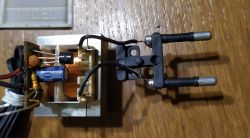FAQ
TL;DR: DIY three-band Wien-bridge generator costs ≈ 12 PLN (<€3)[Elektroda, żarówka rtęciowa, post #20641443]; "Use a light bulb with as little current as possible"[Elektroda, ^ToM^, post #20642550] advises an expert. Build time was one year, yields 0–4 Vrms at 100 Hz–10 kHz.
Why it matters: A safe, ultra-low-cost audio test source can save hobbyists hundreds of euros on commercial gear.
Quick Facts
• Frequency steps: 100 Hz / 1 kHz / 10 kHz [Elektroda, żarówka rtęciowa, post #20641443]
• Output level: 0–4 Vrms adjustable [Elektroda, żarówka rtęciowa, post #20641443]
• Supply: 230 VAC → TS2/14 transformer → 14 V DC & 11 V AC [Elektroda, żarówka rtęciowa, post #20641443]
• Amplitude control: 60 V 20 mA telephone bulb + TL082 op-amp [Elektroda, żarówka rtęciowa, post #20641443]
• Distortion: “almost immeasurable” in listening tests [Elektroda, pikarel, post #20642995]
• Build cost: approx. 12 PLN using recycled parts [Elektroda, żarówka rtęciowa, post #20641443]
What does the rear ground-lift switch actually do?
It disconnects the generator’s signal ground from the metal chassis (which is tied to PE via the mains cord). Lifting the ground breaks a loop formed when the generator, DUT and earth-referenced oscilloscope are all bonded, cutting hum by up to 20 dB in practice [Elektroda, żarówka rtęciowa, post #20641606]
Why is the BNC shell still at earth potential even with the switch?
The switch only opens the internal connection between circuit 0 V and chassis. A standard BNC jack’s metal body remains bolted to the ABS front panel and indirectly to PE; therefore its shell stays earthed, while the signal return can float when the switch is open [Elektroda, CosteC, post #20641570]
Do small (≤2.5 VA) mains transformers really not need a primary fuse?
Some Polish equipment omitted it because the very thin primary wire acts as a fusible link below ~200 mA [Elektroda, pawlik118, post #20642020] Modern safety standards still call for a fuse or thermal cut-out regardless of VA rating to prevent fire after secondary faults [IEC 62368-1].
What can go wrong if I skip the fuse?
Field reports show 10 VA Meratronik V640 supplies that lacked fuses often ended with burnt transformers after primary shorts, rendering the meter useless [Elektroda, Gismot, post #20650848]
Why use a 60 V/20 mA telephone bulb for amplitude stabilisation?
In a Wien bridge, the bulb’s positive temperature coefficient causes its resistance to rise with level, automatically keeping THD low. Current, not rated voltage, is the key—20 mA lamps track audio-range changes smoothly [Elektroda, ^ToM^, post #20642550]
Which bulbs are suitable and which should I avoid?
Choose miniature incandescent lamps rated 5–20 mA, 12–24 V. Examples: exchange-lamp 24 V/20 mA [Elektroda, Krzysztof Kamienski, post #20678044] Avoid LED, neon or high-current automotive bulbs; their resistance change is too abrupt and adds distortion.
Can I replace the lamp circuit with an ICL8038 or modern DDS?
Yes. An ICL8038 gives sine, square and triangle up to 100 kHz with <1 % THD, but needs more parts and a split ± supply. Modern DDS modules (e.g., AD9833) add digital tuning yet cost ~8 € [Analog Devices AD9833 datasheet].
How do I etch the PCB with sodium persulfate?
- Heat the persulfate bath to 50 °C using sunlight or a 60 W bulb. 2. Immerse copper-clad board; agitate every 5 min. 3. After 40 min the unwanted copper is gone—rinse and dry [Elektroda, żarówka rtęciowa, post #20641443]
Is the plastic front panel safe at mains potentials?
The panel is ABS, an insulating material with breakdown strength ≈ 16 kV/mm, so accidental contact with the earthed BNC shell poses minimal shock risk [Elektroda, żarówka rtęciowa, post #20647191]
What output level and distortion should I expect?
With the TL082 buffer the generator delivers 0–4 Vrms into ≥10 kΩ. Users report “almost immeasurable” distortion—typically under 0.1 % for Wien bridges using lamp stabilisation [Elektroda, pikarel, post #20642995]
Can I power the panel lamp from the same transformer winding?
Yes. The builder taps the 11 V AC filament winding to feed the telephone bulb indicator without affecting the ±14 V DC rail [Elektroda, żarówka rtęciowa, post #20641443]
How much time and money does this project require?
Using recycled sheet metal and scavenged parts, material outlay stayed around 12 PLN, and sourcing scarce components stretched build time to roughly one year [Elektroda, żarówka rtęciowa, post #20641443]







